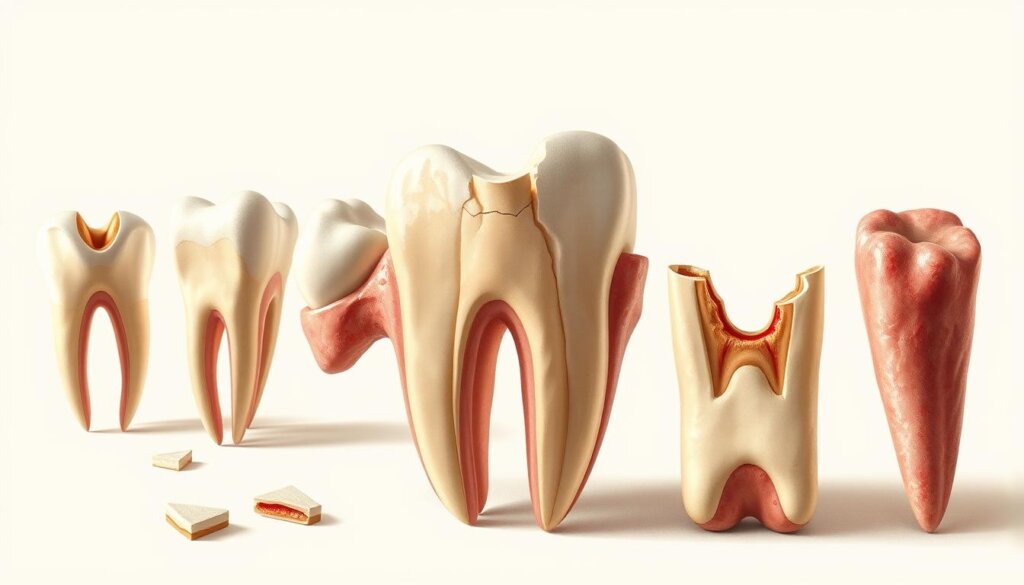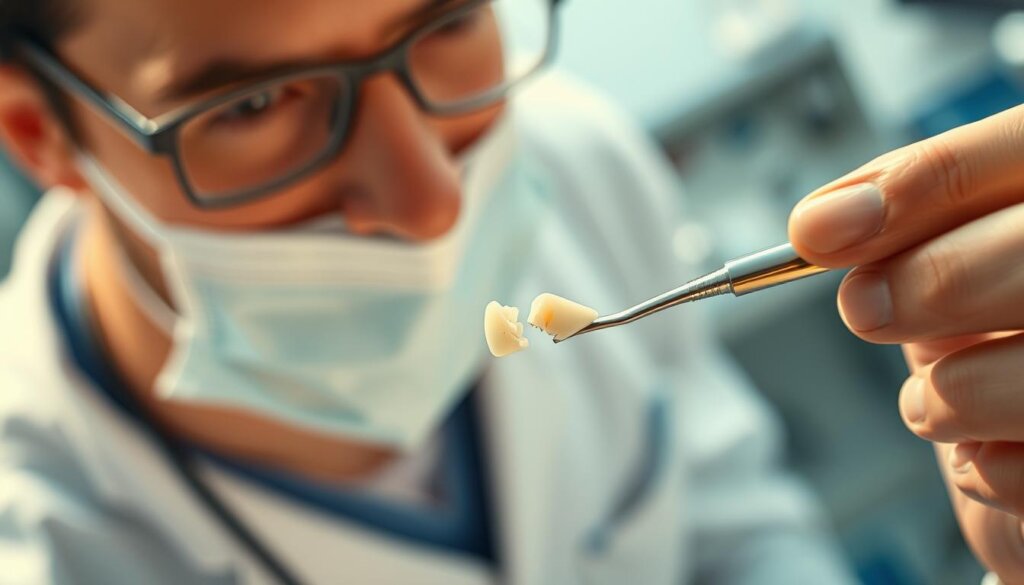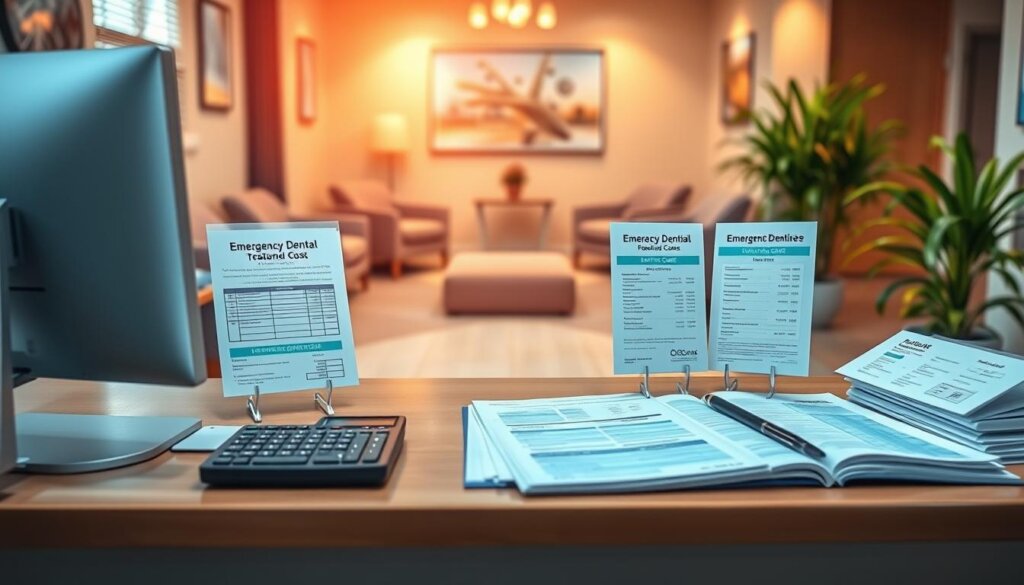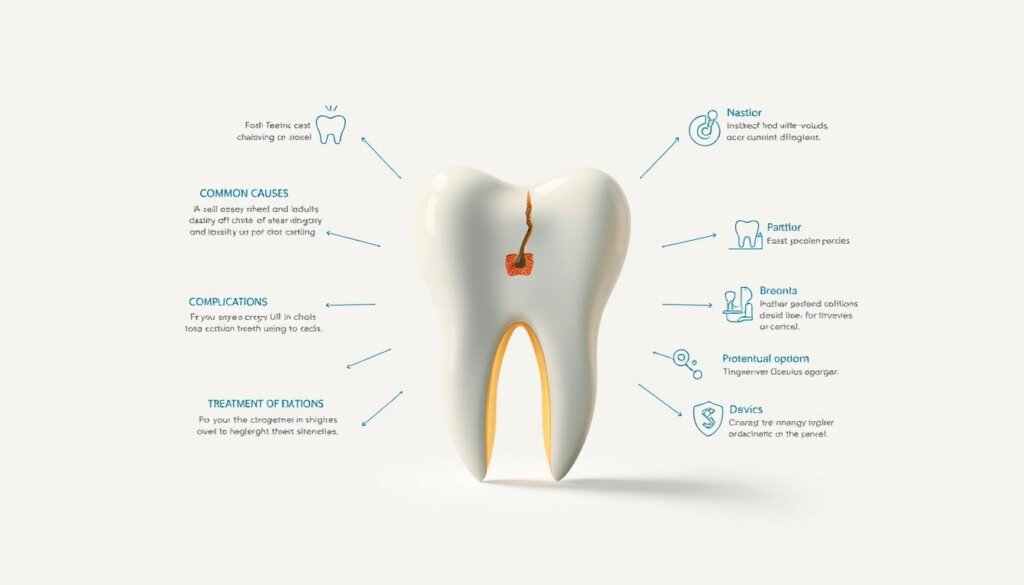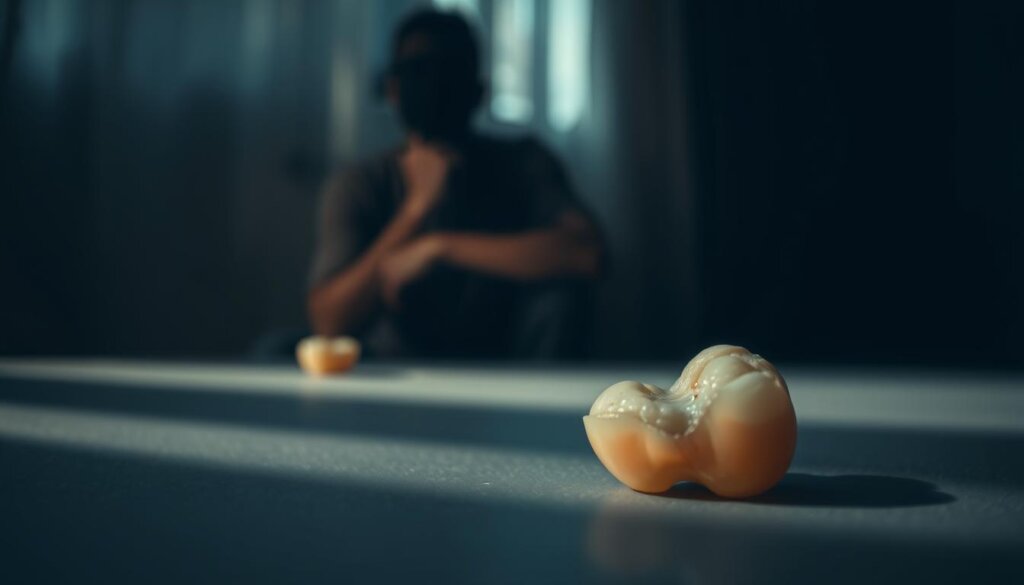Is a Broken Tooth Considered a Dental Emergency?
Every year in the U.S., over 5 million teeth get knocked out. Many of these need emergency fixes due to cracks and breaks. This high number shows how common and urgent dental injuries are. It highlights why knowing whether a broken tooth needs emergency care is crucial. A cracked molar or chipped incisor is not just about looks. It often needs fast help from a dentist who can handle emergencies. Knowing when to get urgent care can stop further health problems.
If you injure a tooth badly, it’s key to know what to do right away. This helps keep your teeth healthy and strong. If you feel a lot of pain or lose a big piece of a tooth, getting fast and right care is vital. These are clear signs of a dental emergency. Dentists who are experts in quick oral care are ready to help. They protect against more issues a broken tooth can cause.
Key Takeaways
- The sheer number of dental injuries annually categorizes a broken tooth as a common and serious dental emergency.
- Immediate actions following a tooth injury emergency can greatly alter the long-term outcome for oral health.
- Severe pain, sensitivity, and visible damage are clear indicators necessitating an emergency dentist for broken tooth situations.
- Timely urgent dental care for a broken tooth is not merely about pain relief—it’s integral to avoiding further complications like infection or abscess.
- Having knowledge of what constitutes a dental emergency helps in making informed decisions regarding when to seek help.
Understanding Dental Emergencies
Knowing what counts as a dental emergency is key for oral health. Quick action can stop pain and avoid bigger health problems. It is important whether you have a cracked tooth or need care for a broken tooth right away.
Definition of a Dental Emergency
A dental emergency means you need to see a dentist right away. These cases usually involve a lot of pain, big damage, or problems that could get worse without fast help. Moving quickly not only eases pain but also prevents serious issues.
Common Types of Dental Emergencies
It’s crucial to know what counts as a dental emergency. Here are some common emergencies that need quick dental care:
- Severe toothache that disrupts daily activities
- Knocked-out teeth, especially due to accidents or sport injuries
- Cracked tooth emergency causing significant pain or discomfort
- Abscesses that are painful and could potentially spread infection
- Injuries leading to excessive bleeding of the gums or oral cavity
If you face any of these, seeing a dentist without delay is key. Some situations might need different care methods, as we will explain next.
Next, we’ll show a table with different dental emergencies, their signs, and why immediate care is important:
| Dental Emergency Type | Signs and Symptoms | Immediate Action Required |
|---|---|---|
| Severe toothache | Consistent, severe pain, possibly with swelling | Yes, seek immediate pain relief and dentist consultation |
| Knocked-out tooth | Visible missing tooth, bleeding | Yes, immediate dental care can potentially save the tooth |
| Cracked tooth | Visibly damaged tooth, pain while chewing, sensitivity to temperature | Yes, to prevent further damage or infection |
| Dental abscess | Sensitivity, swelling, pain, elevated temperature | Yes, to address infection risk and relieve pain |
| Excessive bleeding | Continuous bleeding post-injury, pain | Yes, to control bleeding and prevent further complications |
Finally, knowing when to see a dentist for a cracked tooth or any oral injury is crucial. Getting help fast for a broken tooth can manage pain and stop worse issues.
Signs You Have a Broken Tooth
Spotting a dental emergency broken tooth early can make fixing it more effective. Symptoms can range from a little discomfort to severe, sharp pain. It’s key to be aware so you can act fast.
Signs of a broken tooth include sudden pain when you chew. This happens because the broken pieces move, touching the nerves. You might also feel more sensitive to hot, cold, or sweet things. This means the outer hard layer is damaged, showing the tender layers below.
- Sharp pain during chewing
- Sensitivity to hot, cold, or sweet foods
- Visible signs of a crack or chip
- Swelling around the tooth or gum area
The pain from a broken tooth can vary a lot. It depends on how bad the fracture is and where it’s located. Minor cracks might cause a bit of pain with certain foods. But a big crack down to the nerve can cause ongoing, severe pain. This needs fast broken tooth treatment.
Seeing your dentist regularly can help find and fix fractures early. This stops them from turning into big dental emergency broken tooth problems. If you have any symptoms mentioned, see a dentist right away. This way, you can avoid worse damage or infection.
When to Seek Immediate Care
Knowing when to call for urgent help with a broken tooth is key. It helps avoid more problems. Spotting when a tooth break is an emergency can save the tooth and prevent health issues.
Indicators That Require Urgent Attention
It’s crucial to seek immediate dental care for certain symptoms after a tooth injury. Symptoms include severe pain, visible cracks, or major damage affecting eating or talking. Even minor bleeding or sensitivity needs fast checking by a professional.
Other critical symptoms include:
- Swelling in the gum area around the tooth or in the face
- Signs of infection, like an abscess or bad taste in the mouth
- Loosening of the tooth
Risks of Delaying Treatment
Waiting too long after a tooth break can cause big problems, making it a dental emergency. Is a broken tooth considered a dental emergency? Yes, because the infection risk is high. It can spread to nearby teeth or even into the bloodstream.
Additional risks include:
- Worse damage to the tooth
- Needing serious treatments later, like root canals or tooth removal
- More pain
Quickly dealing with a broken tooth is vital for dental health and overall well-being. Going to an emergency dentist not only helps with the pain but also lowers the chance of more problems.
Types of Broken Teeth
In the world of dental emergencies, it’s important to know the different kinds of broken teeth. From a simple chipped tooth that just affects your smile to a serious fractured tooth that hurts the tooth’s health and strength.
Chips vs. Cracks
Chips in teeth are common and usually less serious. They mean just a small part of the tooth enamel is gone. This kind of damage doesn’t usually reach the tooth’s inner layers like the dentin or pulp, unless it’s ignored. Then, it could get worse.
Cracks, though, are more serious. They might not be seen with the eye but can go deep into the tooth, even to the nerve. This not only hurts a lot but can also lead to infections.
Fractured Teeth and Their Implications
A fractured tooth means the crack has gone deep, maybe even to the root. This is more severe than a small chip or crack because it can hurt the nerve and cause a lot of pain. If not treated quickly, it could lead to losing the tooth.
The table below shows the different types of tooth damage, their signs, and what they could mean:
| Type of Damage | Visual Symptoms | Potential Complications |
|---|---|---|
| Chipped Tooth | Small flake missing from enamel | Mostly cosmetic, risk of decay if untreated |
| Cracked Tooth | Thin line visible, sometimes invisible without magnification | Pain, sensitivity, risk of deeper fracture |
| Fractured Tooth | Visible break, possible missing piece | Severe pain, nerve damage, tooth loss risk |
Knowing whether a tooth is chipped, cracked, or fractured is key. Each type needs different urgent care. Timely dental advice is vital for healing and keeping good oral health.
First Aid for a Broken Tooth
When you have a broken tooth, it’s crucial to act fast. The first steps you take can really affect how well the tooth can be fixed later.
Rinsing your mouth with warm salt water is a good starting point. This helps clean the area and fight off infection. Putting a cold pack on your cheek can help with swelling and pain.
To stop any bleeding, press on it with sterile gauze. If it keeps bleeding for more than 10 minutes, you need to see a dentist right away. This could mean it’s serious.
- Use of Over-the-Counter Pain Relievers: If your tooth hurts, taking pain relievers can help. Just make sure to follow the instructions on the bottle.
- Avoid Hard Foods: Try not to chew hard stuff on the side where your tooth is broken.
- Avoid Extreme Temperatures: Eating things that are too hot or too cold can hurt, so stick to foods that are room temperature.
Keeping the broken tooth area clean is really important. Brush and floss there, but be gentle so you don’t make it worse.
These steps are key for taking care of a broken tooth until you can get to a dentist. But don’t forget, they don’t replace professional help. You should still see a dentist as soon as possible.
What to Expect at the Dentist
When you have a dental emergency like a broken tooth, seeing an emergency dentist is key. They first check the tooth to see how bad the damage is. They’ll talk about the best way to fix it. This helps lower worry and gets you ready for what’s ahead.
At the start, the emergency dentist broken tooth experts look closely at your tooth. They might use X-rays to find out exactly where and how bad the break is. The main aim is to figure out how it affects your mouth right now and what could happen later.
After checking your tooth, the dentist will talk about ways to fix it. The choice depends on how the tooth broke. Options include dental bonding, crowns, or a root canal if the inside of the tooth is hurt. The table below shows different treatments and what they do to make your tooth look and work right again:
| Treatment Type | Description | Objective |
|---|---|---|
| Dental Bonding | A resin put on the tooth to fix small breaks and chips. | Makes the tooth look and work right again. Also keeps more damage from happening. |
| Crown | A cover put over the tooth to hide the broken part. | Makes the tooth stronger, look better, and last longer. |
| Root Canal | Taking out hurt pulp, cleaning the canal, and closing it up. | Stops more germs from getting in and saves your tooth from being pulled out. |
Knowing these steps and their role in broken tooth treatment makes a big difference in healing. It helps you get better faster and get back to normal with your teeth.
Treatment Options for Broken Teeth
Dealing with a broken tooth is urgent. Different treatments can fix your smile and functionality. The right choice depends on how badly the tooth is damaged. Let’s dive into two main fixes: dental crowns and dental bonding.
Dental Crowns for Broken Teeth: Perfect for serious breaks, dental crowns cover the damaged tooth. They are made from ceramic or porcelain to look just like real teeth. Crowns are strong, look natural, and protect the tooth from more harm. They’re great when the tooth’s structure is weakened. They help keep the tooth safe for a long time.
Dental Bonding for Tooth Repair: For smaller damage, dental bonding is a quick fix. A tooth-colored resin is applied and shaped to look like the original tooth. It’s then set with a special light. Dental bonding is affordable and saves more of the tooth’s enamel. It’s a top pick for fixing small chips and cracks fast.
| Feature | Dental Crowns | Dental Bonding |
|---|---|---|
| Material Used | Ceramic, Porcelain | Composite Resin |
| Durability | High | Moderate |
| Procedure Time | Two visits | Single visit |
| Use Case | Severe fractures | Minor chips and cracks |
In conclusion, dental crowns and bonding fix different tooth damages. Your dentist will suggest the best method. This ensures you get a healthy and working smile again.
Possible Complications of Untreated Broken Teeth
When you don’t treat a broken tooth, the stakes are high. Getting dental care quickly is crucial. It keeps your mouth healthy and lowers risks to your overall health. Ignoring a broken tooth can lead to serious problems. It’s vital to handle these issues quickly to avoid worse health troubles.
Infection risk in broken teeth jumps if you ignore the problem. A crack in the tooth lets germs get inside, possibly causing infection or an abscess. This infection can spread, threatening your health.
Risks to dental and systemic health increase significantly with any delay in addressing a broken tooth. Immediate consultation with a dental professional is imperative.
A broken tooth can affect the health of nearby teeth. It can stress other teeth, mess up how your teeth fit together, and lead to more cracks or even tooth loss.
| Condition | Short-term Effects | Long-term Consequences |
|---|---|---|
| Untreated Broken Tooth | Increased sensitivity, pain, risk of localized infection | Spreading of infection, potential loss of tooth, reduced jaw integrity |
| Impacted Surrounding Teeth | Altered load distribution, discomfort | Enhanced wear, risk of additional dental fractures |
Quickly treating a broken tooth helps save it and keeps your mouth healthy. Knowing the risks of ignoring a broken tooth shows why you shouldn’t wait to get care. Regular dentist visits and good mouth care can prevent initial damage and risks tied to broken teeth.
Preventative Measures for Dental Health
Keeping your teeth healthy for a long time involves using dental prevention methods. These include regular dental checkups and wearing mouthguards during sports.
Regular Dental Checkups: Going to the dentist often is crucial for catching and treating dental problems early. These aren’t just simple check-ups. They prevent cavities and broken teeth. Each visit gives personalised advice and care for your teeth.
Importance of Wearing Mouthguards: For those playing sports, mouthguards are key to preventing teeth injuries. They protect against hits that could cause big dental emergencies. Dentists make the best mouthguards because they fit perfectly and are made of the best materials.
Avoid using your teeth as tools and stay away from hard or sticky foods to keep them strong. These practices lower the risk of teeth injuries and decay. They help maintain a healthy and vibrant smile.
Cost Considerations for Treatment
Having a broken tooth can cause a lot of worry. This isn’t just because of the pain but the costs for emergency dental care too. It’s important to know about the costs for fixing your tooth. This helps in handling the situation well. Let’s look at the average costs for different dental fix-ups and how dental insurance can help with the costs.
The cost of broken tooth treatment changes a lot based on how bad the damage is and what needs to be done. Simple fixes like dental bonding may not cost much. But, bigger repairs like crowns or root canals will cost more. This is because they are more complex and need special materials.
| Treatment | Average Cost |
|---|---|
| Bonding | $300 – $600 |
| Dental Crowns | $1,000 – $3,500 |
| Root Canals | $700 – $1,500 |
| Extraction (if necessary) | $200 – $700 |
Dental insurance is very important in managing these costs. What insurance covers can change a lot depending on your plan. Most insurance plans help pay for necessary treatments like fixing a broken tooth. It’s a good idea to talk to your insurance company to know exactly what they cover and what your costs might be.
Your personal situation impacts your costs too. Your dental insurance might have a yearly cap, deductible, and co-pays. These affect how much you actually spend on emergency dental care. Knowing these details beforehand can make it less stressful to plan for these costs.
Knowing well about the costs and what your dental insurance offers helps a lot. This can make the tough experience of having a broken tooth a bit easier to deal with.
Myths vs. Facts About Broken Teeth
Knowing the truth about dental emergency myths can change how you deal with a broken tooth. By learning the real tooth injury misconceptions and true broken tooth facts, it’s easier to know what to do. It also helps lower worry about your teeth’s health.
A big dental emergency myth is thinking all broken teeth need quick care. Yes, deep breaks or nerve damage do need fast help, but small chips might not be urgent. It’s vital to see a dentist to find out how bad the injury is.
Some believe that only visible damage means a bad problem. Yet, some cracks can’t be seen without a close dental check-up. This wrong belief might make you not take a tooth crack seriously. So, seeing a dentist for a detailed check is very important.
- Myth: Only a lot of pain means the tooth problem is big.
- Fact: Serious tooth issues can happen with little or even no pain.
We don’t just want to correct tooth injury misconceptions; we want to help you make good choices about your teeth. Knowing more can lead to better care and help prevent big tooth problems. In the end, really understanding the truth lets you know what to expect for fixing your teeth and keeping them healthy.
Impact on Daily Life
A broken tooth can really mess up your day. It affects not just your dental health but your daily life too. This part talks about the challenges damaged teeth bring.
Effect on Eating and Speaking
A cracked tooth makes eating and talking tough. You might avoid certain foods because of pain, which could hurt your nutrition. Trying to speak clearly might be hard too, causing a lot of frustration.
Psychological Effects of a Broken Tooth
The psychological impact of tooth injury is big. Damage to front teeth can shake up how you see yourself and lower your confidence. Feeling nervous or avoiding social stuff is common, leading to feeling lonely. All this happens because of the broken tooth inconveniences.
| Impact on Function | Psychological Impact |
|---|---|
| Limited food choices due to pain | Reduced self-esteem from visible damage |
| Difficulty in clear speech | Social withdrawal and anxiety |
| Need for modified eating habits | Perception of attractiveness and professionalism |
Taking care of these issues fast can help a lot. Fixing broken teeth quickly is good for both your dental health and daily life. It reduces the trouble caused by these injuries.
Long-term Care for a Broken Tooth
The journey to heal a broken tooth goes beyond just the first treatment. It involves careful, ongoing care to keep your mouth healthy. This care includes keeping your mouth clean and going to the dentist regularly.
Maintaining oral hygiene is crucial for the long-term health of a broken tooth. Brushing twice daily with fluoride toothpaste, flossing, and using antiseptic mouthwash are key. These steps prevent further decay and other problems. They help the injured tooth and improve your overall oral health. This protects you from future dental problems.
Regular trips to the dentist are just as important as dental follow-up care. These visits let your dentist check on the repaired tooth and spot any new issues early. This is vital to keep your initial treatment working well. It also helps make any needed changes and shows you’re serious about keeping your mouth healthy.
The idea of broken tooth long-term management means doing more than just seeing your dentist now and then. It’s about following your dentist’s advice closely and taking care of your teeth diligently. By sticking to your dental care plan and keeping your mouth clean, you can make your dental treatment last longer. This helps keep your teeth healthy for the future.
Conclusion: Taking Action is Key
Understanding the urgency and methods for treating a broken tooth is crucial. It can mean the difference between minor and major dental treatments. This piece covered recognizing dental emergencies, evaluating a broken tooth, and essential steps for oral health.
Prompt treatment can greatly reduce the risk of severe complications. These complications can affect not just oral health but overall well-being too.
Recap of Importance of Prompt Treatment
The key point is how vital immediate dental treatment is after a dental emergency. Awareness of urgent care signs helps medical professionals and patients act quickly. Fast action can save the function and look of your teeth and protect against infections.
Encouragement to Prioritize Dental Health
It’s critical to prioritize dental health. Beyond reacting to problems, preventative care is vital. This includes regular check-ups and using protective gear like mouthguards.
Dentists play a major role in promoting preventive strategies and providing crucial treatments. Let’s make our dental health a priority for a brighter, healthier smile.

